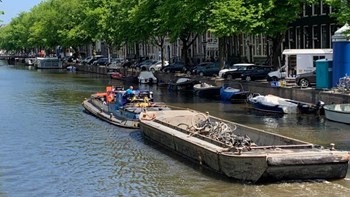
Valuing the water in Amsterdam
2 March 2021
On 22 March of each year we celebrate World Water Day, which celebrates water and raises awareness of the global water crisis. As Amsterdam is a city filled with water and canals, the quality of the water is important to everyone in the city. With over 100 km in canals and over 1900 bridges, the city of Amsterdam knows a thing or two about water management.
Once upon a time, the city's Dam Square was an actual dam between the River Amstel and the Southern Sea (or Zuiderzee), this dam gave the city its name. Yet today it is one of the few places in the city which you cannot reach by boat, the closest you can get is Damrak, Oudezijds Voorburgwal or Singel.
Canals in Amsterdam
The first canals were dug for water management and as city defences. As the city grew and its walls were moved further out, successive defensive moats became part of the inner city and the moats were repurposed as canals to help with the local transport of merchandise. This gave the city its unique look and canal belt.
In the 17th century Dutch trade grew exponentially, during a time that become known as the Golden Age for the country, and an ambitious project was started that took 50 years. This project created the city's four main canals and the canal houses that stand on their shores, the Herengracht, Keizersgracht, Prinsengracht and Singel.
Water quality
In the past, Amsterdam and her citizens did not properly value the water that flowed through the city. For hundreds of years the canals were treated as garbage dumps and sewer systems and through to the mid-19th century the water in the canals was stagnant, which did not help to get rid of the smell.
But today the water in Amsterdam is cleaner than it has ever been. Cleaning the canal system properly started with the building of the steam-powered pump station Gemaal Zeeburg in 1879. The pump station flushed the city with clean water from the Southern Sea. And the situation was further improved when the inner city was connected to the sewer system in 1935, though it took till 1987 for the entire canal belt to be connected.
Today, 14 of the 16 existing water locks around the city close three times per week so that clean water from the IJsselmeer can be pumped in. The current created by the pumps pushes the dirty water out through the open locks at the other side of the city.
But there is more than dirt in Amsterdam's waterways, one of those things is very specifically Dutch. Each year, between 12,000 and 15,000 bikes are pulled out of the canals by barges with cranes mounted on them. Locally this cleaning process is known as bike fishing.
The cleaner water has brought life back to the canals. About 20 different species of fish and crabs live beneath the surface and they attract water birds like herons, ducks, coots, gulls and even cormorants. But its not only fish that swim in the canals.
People, too, now swim through the city on occasion. Such as during the Amsterdam City Swim, a charity event which raises money to fight ALS. Important to note: swimming in the canals is illegal and you run the risk of a €140 fine. If the Amsterdam heat is getting to you in summer, pay attention to the locals and follow their lead on where to swim.